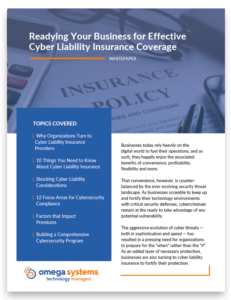

Beyond satisfying increasing regulatory demands and standards set forth by clients, investors, boards of directors and other stakeholders, businesses across nearly every industry are also contending with high standards for securing cybersecurity liability insurance. These policies – once nice-to-haves – are now becoming the norm for any organization that handles personal or sensitive data.
Even for those who’ve previously secured coverage, expectations (and premiums) are increasing. So how do you ready your business for effective coverage? Here are 10 critical things to know.
As you set about looking for cyber insurance coverage, it’s essential that you know what it typically covers, what information you’ll need to provide or validate before you can get it and what it will cost your organization. Take a closer look at some of the most critical details related to securing cybersecurity insurance coverage.
The simple answer is that every business needs cyber liability insurance.
Every business in every industry is vulnerable to a cybersecurity incident. While of course there are varying levels of exposure, you should assume if your business handles any sort of sensitive information (customer PII, credit card/banking information, medical information, etc.), that you need cyber liability insurance. Your standard corporate policy likely does not cover cybersecurity-related incidents, and thus, you’ll need to explore stand-alone coverage.
Obtaining cybersecurity coverage can be challenging, but there are steps you can take to make your organization more attractive to an insurance provider.
Truth be told – securing cyber liability coverage is not a fast or easy process. Many businesses are finding it difficult to qualify, as carriers rapidly increase their expectations and standards. Insurance applications can be extremely detailed, and many providers also require companies to benchmark their cyber risk programs against comprehensive compliance frameworks such as NIST.
If your company has had a claim previously, getting coverage can be especially challenging.
Cyber liability insurance coverage can be expensive. Premiums have gone up dramatically in recent years and are expected to continue to increase.
How much your organization pays for a policy is based on multiple factors, including your location, company policies, and incident or data loss history. Your industry can also affect your coverage and overall costs. Certain sectors, like financial services and healthcare, are more frequently the target of cyberattacks. Insurers typically charge organizations in those industries higher premiums.
You need a cyber liability insurance policy that protects your organization from the risks it’s most likely to face. What cyber liability insurance covers depends on the type of policy. Policies generally provide first-party coverage and cyber liability or third-party coverage. First-party coverage usually handles the cost of:
Third-party coverage typically covers the cost of:
In addition to the aforementioned variables, your company’s insurance coverage will most significantly be dictated by your level of security risk – and the programs you’ve implemented to mitigate said risk. Most businesses, unfortunately, have very little insight into their specific risks and vulnerabilities, as well as how those risks correlate to the value of their sensitive data. Emerging technologies like data discovery can give companies a leg up in identifying critical vulnerabilities and providing transparency into the potential financial impact of security incidents.
Every policy is different, but most cyber liability policies do not cover future financial losses, system and technology upgrades, and impacts to company valuation/market share.
Other losses that aren’t typically covered include:
Most corporate policies don’t include cyber liability insurance, meaning you need a separate policy. The odds of experiencing a cyber breach at some point are high, so you need protection even if your company doesn’t handle a significant amount of sensitive information.
Cyber liability insurance can help your company save money if it does experience a breach. It also puts your customers’ minds at ease, and sends a message that your organization takes security and privacy seriously.
Your company’s cyber liability insurance coverage needs may differ considerably from another’s based on your vulnerabilities and risk tolerance.
Coverage typically breaks down into four categories:
Your organization needs to meet the requirements of the policy provider before you can get coverage. Furthermore, getting coverage once doesn’t mean you can put your security on the back burner — your company needs to continually maintain, upgrade and enhance its cybersecurity over time. It’s important to keep up with the insurance policy’s requirements, as they will shift as cyberthreats continue to evolve.
Because of the nature of most cybersecurity breaches and incidents, your cyber insurance application will primarily focus on technology and systems you have in place to protect your network and sensitive data. From firewall protections to monitoring tools to multi-factor authentication software, carriers will ask detailed questions about your hardware and software infrastructure.
While information gathering, cyber insurance carriers will also focus on the policies and procedures you’ve implemented to both prevent cybersecurity risk AND respond to incidents that inevitably occur. This level of detail will help providers verify that you’ve taken the necessary time to think through potential vulnerabilities across your organization and the steps necessary to take to thwart and react to serious cybersecurity incidents.
Want more specifics on the types of security controls you may need to secure effective coverage? Read our Cyber Liability Insurance Checklist.
The application process can be daunting. Your MSP can help you complete your insurance application and provide you with the details about your data protection controls and security policies.
As part of the cyber insurance application process, carriers will want to know if your business is subject to or voluntarily follows any regulatory frameworks or best practices. While certain industries may require compliance with regulatory guidelines (e.g. HIPAA, PCI DSS, SEC, CMMC, etc.), non-regulated businesses may also want to consider proactive compliance with industry-agnostic frameworks, such as the NIST Cybersecurity Framework (CSF), which may help standardize and streamline the insurance application process – plus provide your company with an established roadmap for cybersecurity protection.

If you want the most comprehensive cyber liability insurance and premiums that work with your organization’s budget, Omega Systems can help. We have hands-on experience working with customers across multiple industries as they pursue improved or new cyber liability insurance coverage.
Our security professionals work with you as you design and improve your security across applications, controls, endpoints, written policies and infrastructure. Through our managed IT compliance services, your organization can assess the state of its cybersecurity and IT environment to guide your compliance programs and obtain the cyber insurance coverage you need.

In our whitepaper, Readying Your Business for Effective Cyber Liability Insurance Coverage, we take a closer look at some shocking cyber liability coverage considerations, factors that can affect your insurance premiums and examples of cybersecurity requirements that can help your business prepare to secure coverage.
Download the white paper and contact us with any questions or to discuss your organization’s IT needs.